After a month of excitement in major stadia around Australia and New Zealand, the 2023 FIFA Women’s World Cup is on the home straight, with the semi-finals currently taking centre stage and providing fans with great anticipation and enjoyment.
The first nations in the last four to go head-to-head were Spain and Sweden, who met at Auckland’s Eden Park with the sole aim of sealing a place in Sunday’s final. It was always going to be a mouthwatering prospect to see them lock horns, given that both favour very different styles and tactics (Spain play a very possession-orientated game, whilst Sweden like to hit teams with counterattacks and well-executed transitions).
As this tactical analysis will show, the game itself was a slow burner, with Spain unable to get their key players into the game whilst Sweden failed to match their positive build-up play with quality in the final third.
However, in the end, it was Spain who secured a meeting with either Australia or England on Sunday, whilst Sweden were once again consigned to a semi-final exit and a third/fourth play-off fight.
Lineups
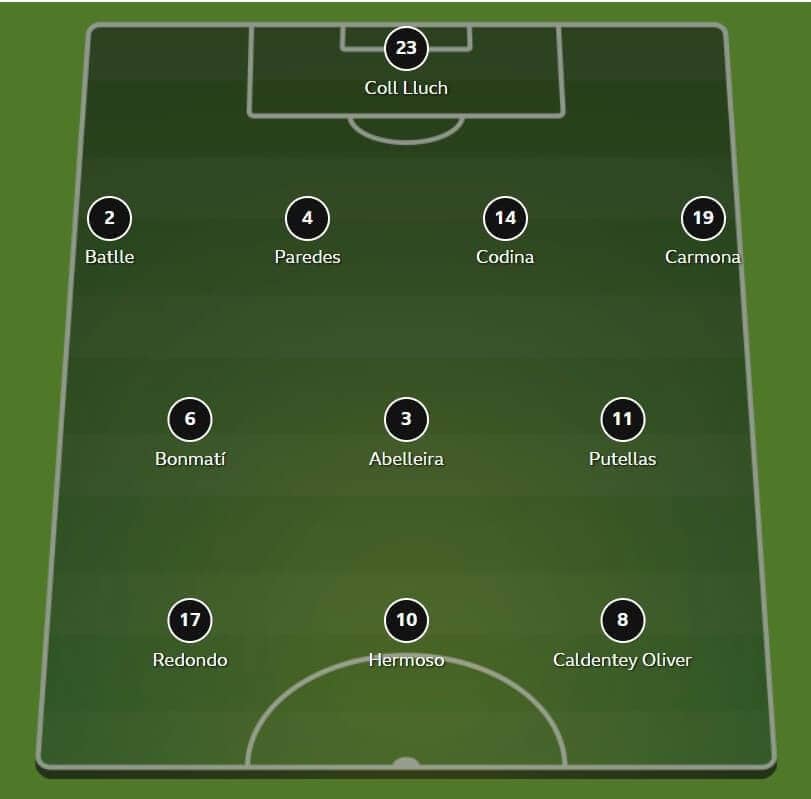
Spain head coach Jorge Vilda made two changes from the side that sent the Netherlands home on Saturday, with new Real Madrid Femenino full-back Oihane Hernández suspended after picking up too many yellow cards, whilst striker Esther González was named on the bench.
In their places, Jennifer Hermoso moved forward to lead the line, with Barcelona Femení playmaker Alexia Putellas taking over from her in the central third, whilst Real Madrid’s Olga Carmona came in at left-back and captained the team, with former Manchester United Women and new Barcelona player Ona Batlle moving across to her favoured right-back role.
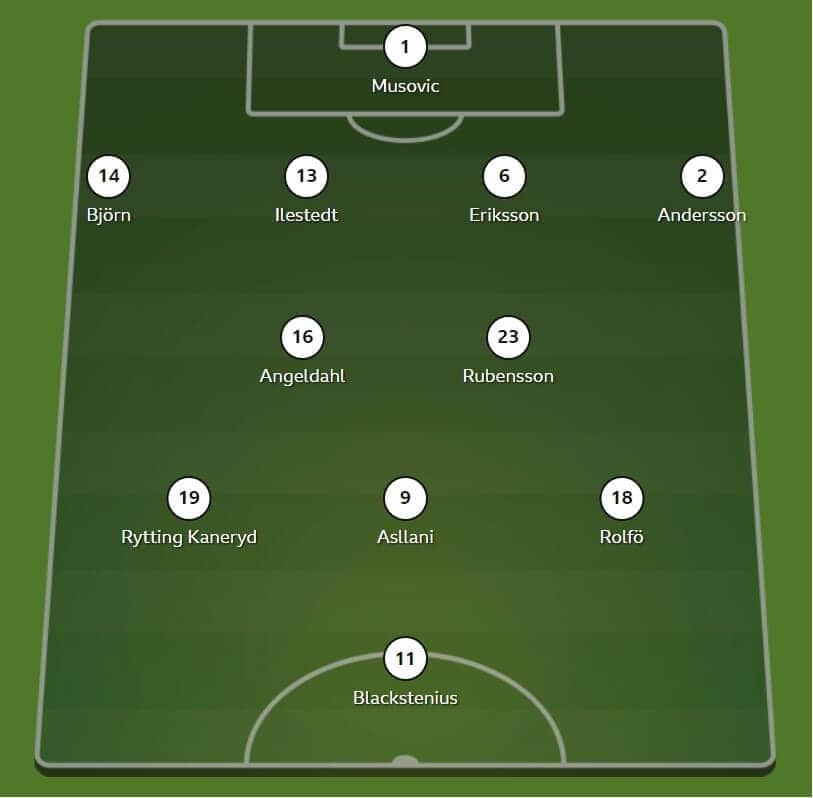
Sweden, meanwhile, opted not to change things around, with Peter Gerhardsson going with a policy of consistency and seeking not to disrupt what worked so well for his team last time out. As a result, Golden Boot contender and new Arsenal Women player Amanda Ilestedt, who has scored four goals so far this tournament, kept her place in central defence alongside former Chelsea Women captain Magdalena Eriksson, whilst another Arsenal player, Stina Blackstenius, was once again tasked with leading the line.
Spain’s mixed first half
When looking at the final score, it would be easy to assume that Spain had the lion’s share of possession and that they needed to be patient and wait for the right chance to present itself. In reality, things were very different, though, with Vilda’s players struggling to implement their fast-paced game plan in the first half and having to work hard to ensure that they went in level at the break.
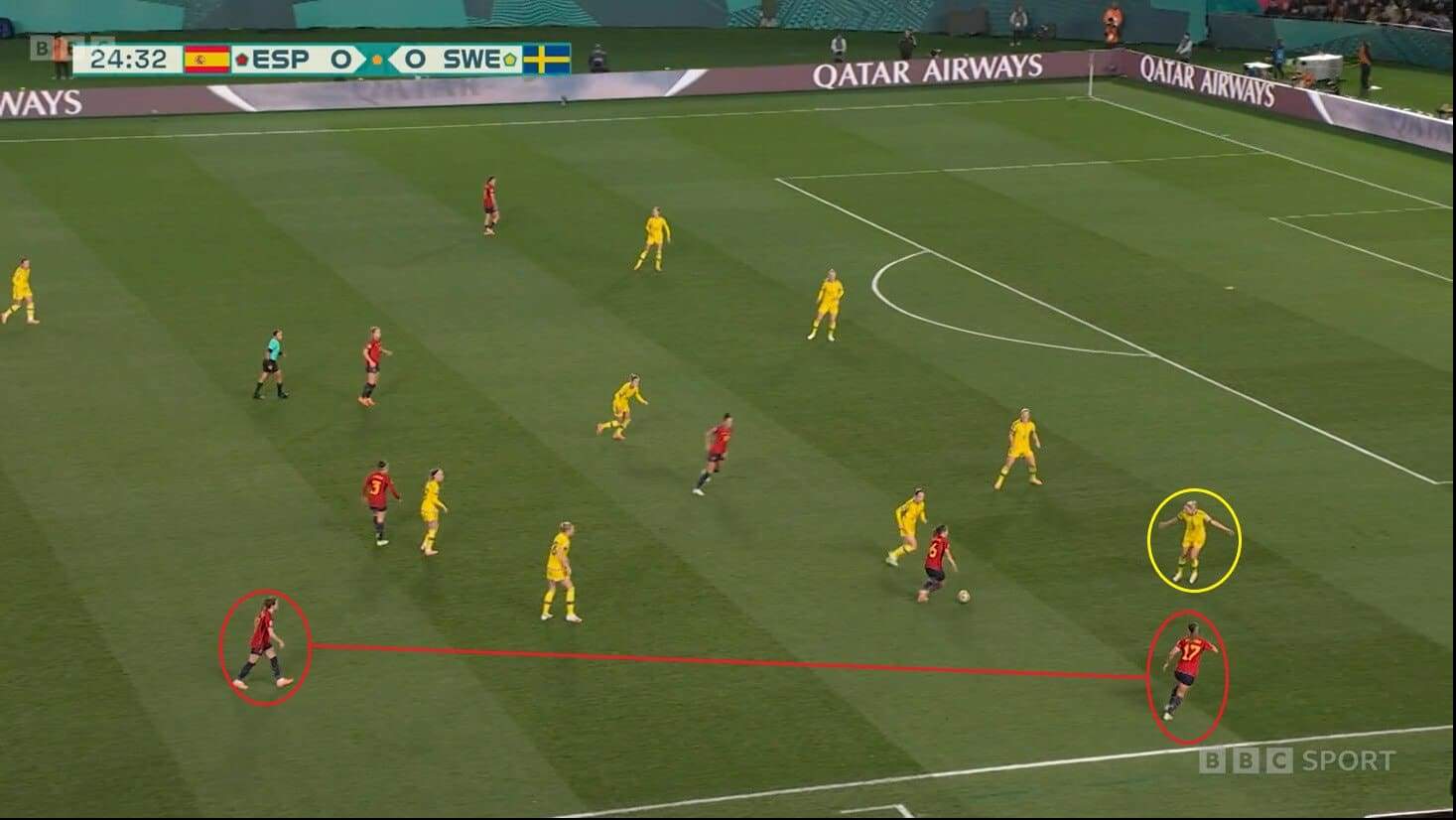
From a tactical point of view, it was clear that Spain had gone with the same mindset as they have done throughout the World Cup, with them trying to create spaces in the middle and ensure that the likes of Aitana Bonmatí and Teresa Abelleira had as much room as possible to instigate their usual devastating passing sequences.
However, Sweden were clearly aware that this would be Spain’s focus and were working hard to prevent the central third from being used against them, and that meant that Spain were forced to depend even more than usual on the ability of their wingers and full-backs to progress the ball up the field and put the Swedish players under pressure.
On the right wing, Batlle and Alba Redondo formed a powerful partnership, with plenty of overlapping and underlapping runs on show, whilst there were examples of good understanding between Mariona Caldentey and Carmona on the opposite side too.
It was no surprise to see Spain make this work for them, as there was an expectation that they would utilise the wings a lot more in this game due to the threat posed by Sweden’s full-backs against Japan and the need to pin them back inside their own third. However, it was the fact that this became their only way of moving the ball into advanced areas that Vilda’s side perhaps weren’t expecting, and that was one of the reasons they struggled to pose the same threat as they did in previous matches.

It was what came next that let Spain down, though, as there were too many occasions when they would move the ball up the wide channels but didn’t have the options to turn that positive build-up play into anything meaningful.
In this case, Redondo has cut inside and is looking to transfer the ball into the middle, but Hermoso is not on the same page and has not read what the Levante Femenino striker is trying to do until it is too late.
As a result, Redondo is forced to hold onto the ball for a fraction of a second longer than she would have liked to and is subsequently pressed by the Swedish players around her, with the result being that they can clear their lines without being tested. However, had Hermoso made her run slightly earlier, things could have ended up very differently.

It wasn’t really Hermoso’s fault that that chance failed to materialise into anything concrete because she was in a position that she has historically thrived in but which she is seldom seen in nowadays.
Instead, she has evolved into much more of the creative midfielder she was in a previous life, with her now someone who likes to drop deep and get on the ball in the central third rather than lead the line. Both Barcelona and current club Pachuca Femenil have allowed her the freedom to drift around the pitch whilst relying on others to lead the line.
To be at her best, she needs to be played in a way that doesn’t constrict her to one particular pitch area, with this heatmap indicating the variety of spaces she accessed last season in Mexico. However, Spain didn’t give her that during the first half, and the result was that they often lacked a central presence, and the overall dynamic didn’t work for them.
Impact of Salma Paralluelo
Changes were undoubtedly required in the second half, and, to his credit, Vilda did make them at the right time to give his team the best possible chance of getting on the scoreboard and winning the game.

The key alteration came on 57 minutes, when Putellas, who had been rendered largely ineffective up to that point, was withdrawn and replaced by talented Barcelona teammate Salma Paralluelo. It was not a like-for-like switch, with Paralluelo ordinarily featuring as a wide forward for the Liga F champions, but it was a move designed to free Hermoso up and to ensure that Spain could ask different questions of their opponents.
With Paralluelo playing through the middle and using her pace to take time away from Sweden’s back line, there was an instant change in mentality as more gaps started to open up between the Swedish lines. That then allowed players like Bonmatí, who had also had a quiet first half, to start making their usual passes and create chances from the central third.
In this case, she has played Redondo through to shoot at goal, and moments like this were not possible before Paralluelo’s arrival and were only now happening because of the impact that she had on their attacking play.
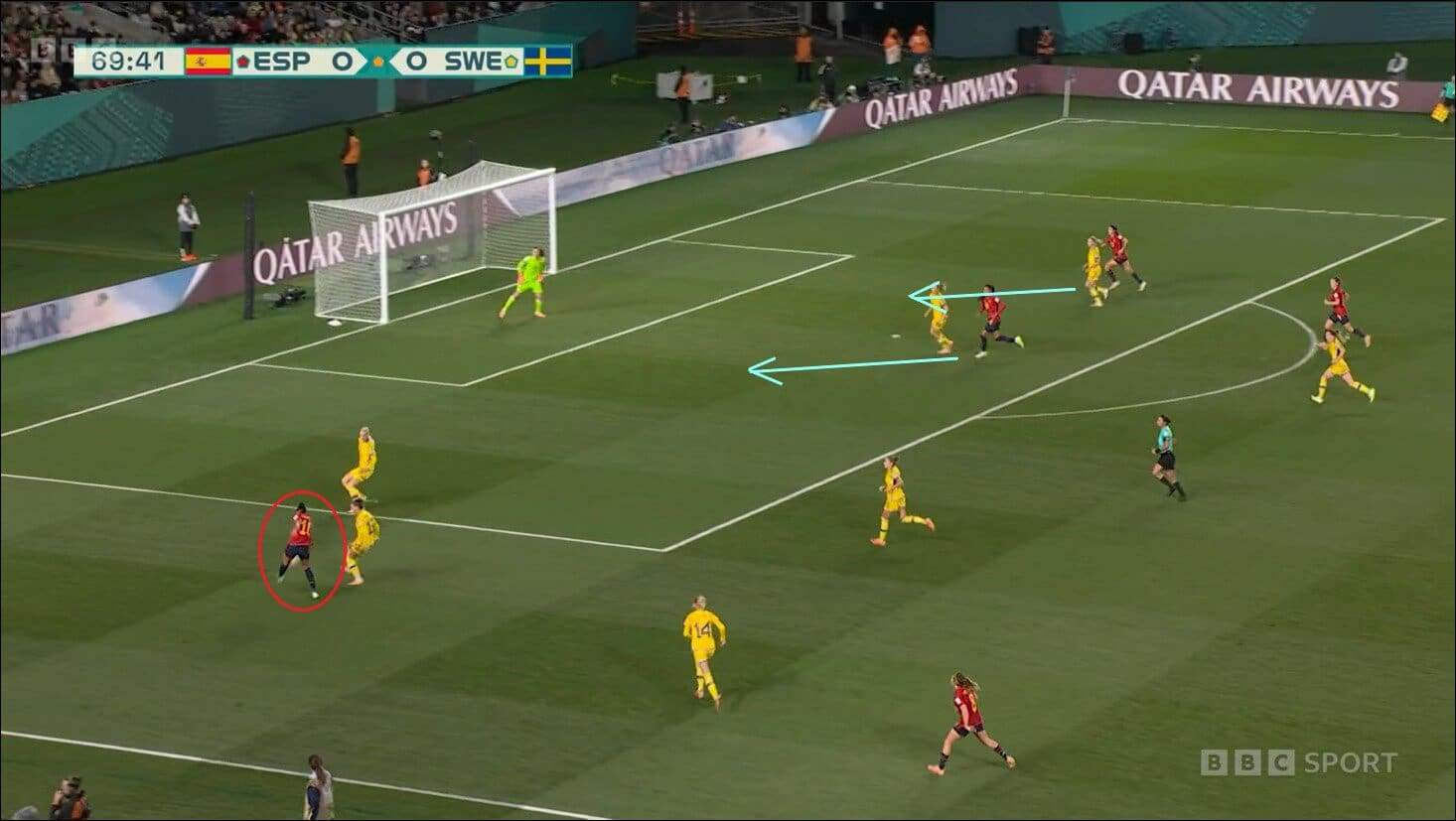
As mentioned, Paralluelo’s introduction had a significant impact on Hermoso, as she could drop back into the midfield role that Putellas had vacated and operate in the areas of the pitch that she has done so well in throughout the tournament. As a result, it was common to see her getting into these types of spaces and showing more confidence in what she was doing.
The fact that she sent the ball into the middle here with her first touch, rather than taking two or three as Spain had been doing before the break, highlighted that rediscovered belief in her performance.
Again though, it all came down to Paralluelo and her impact, with this being another situation in which she made a run that Spain previously weren’t attempting. On this occasion, her diagonal movement took Eriksson out of the picture and gave Redondo a chance to get on the end of Hermoso’s cross, and, even though she was under pressure from Andersson as she received the ball, she still managed to get a shot away at goal. She could have scored here, but for fine margins going against her.
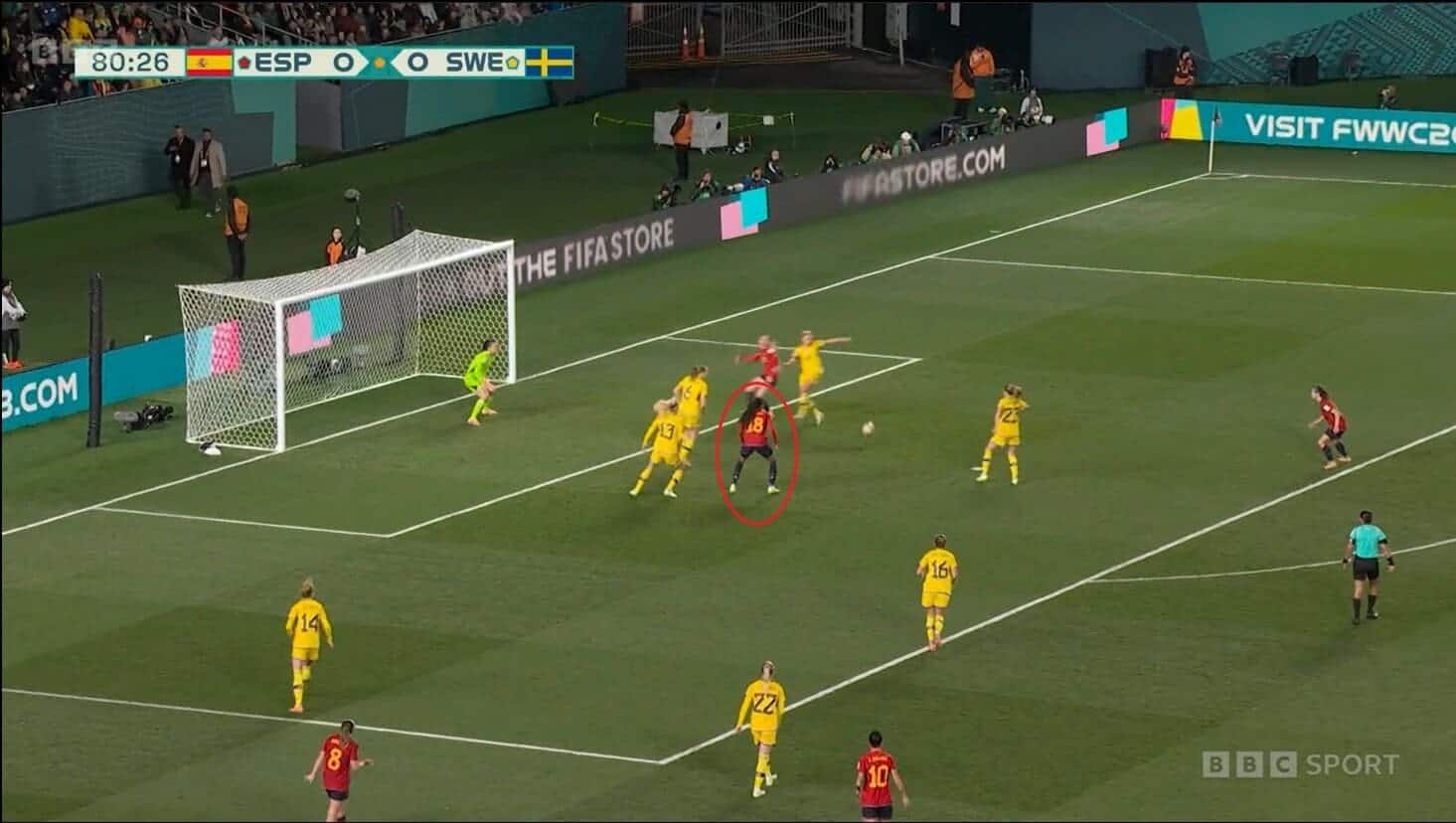
It wasn’t only Paralluelo’s teammates who felt the impact of her arrival, though, with Sweden also struggling to keep their opponents back, and this situation, which shows the build-up to the opening goal, demonstrates how difficult it was for them inside their own third once she was involved in the game.
The construction of the goal was very clever from the Barcelona forward’s point of view because it initially seemed that she was looking to move forward and get between Eriksson and Ilestedt, and that led to both Sweden centre-backs dropping towards their goal as they tried to stop her connecting with the ball.
However, this was only a ploy, and instead, Paralluelo ducked back at the last minute to sit in the space just in front of the Swedish defenders. The added second that bought her meant that, when the ball dropped at her feet from Hermoso’s ricocheted cross, she could spin and put it beyond Chelsea goalkeeper Zećira Mušović.
All in all, when looking for a catalyst that led to Spain taking control of the game, Paralluelo’s arrival has to be considered, and the impetus that she gave them in the final third was undoubtedly paramount to their progression to the final.
Sweden’s pressing tactics
That is not to say, though, that Sweden didn’t play well because there were a lot of moments that they can be proud of and showed just how much of a contribution they have made to the World Cup.

As mentioned, they came into this game with a clear plan to stifle Spain’s central threat and to force them into focusing their efforts on the wings, and it was clear when looking at how they set up to remove the central passes that this was something that they had planned for.
As is the case here, they were forming robust shapes out of possession and working together well to squeeze their opponents against the sidelines. It forced Spain into playing more sideways passes as they tried to access the space they could find. There is no doubt that Vilda’s players needed to rethink a few aspects of their tactics during the early stages because of Sweden’s solid defensive resolve.

Most of the time, Spain did manage to play around this central block, but there were occasions when they tried their luck and tested the waters further inside the pitch.
However, when they did, they only allowed Sweden to put the next phase of their defensive press into action, working together to isolate individual players and prevent them from connecting with those around them.
This was particularly important during transitions and counterattacks, as is happening here, with Sweden quickly dropping back and ending Batlle’s attempt to start an attack. In this case, Batlle’s new Barcelona teammate Fridolina Rolfö made the vital contribution here by forcing the right-back to play sideways and end Spain’s momentum. It was common to see Rolfö dropping back to help without the ball and again indicating how this was a team effort.
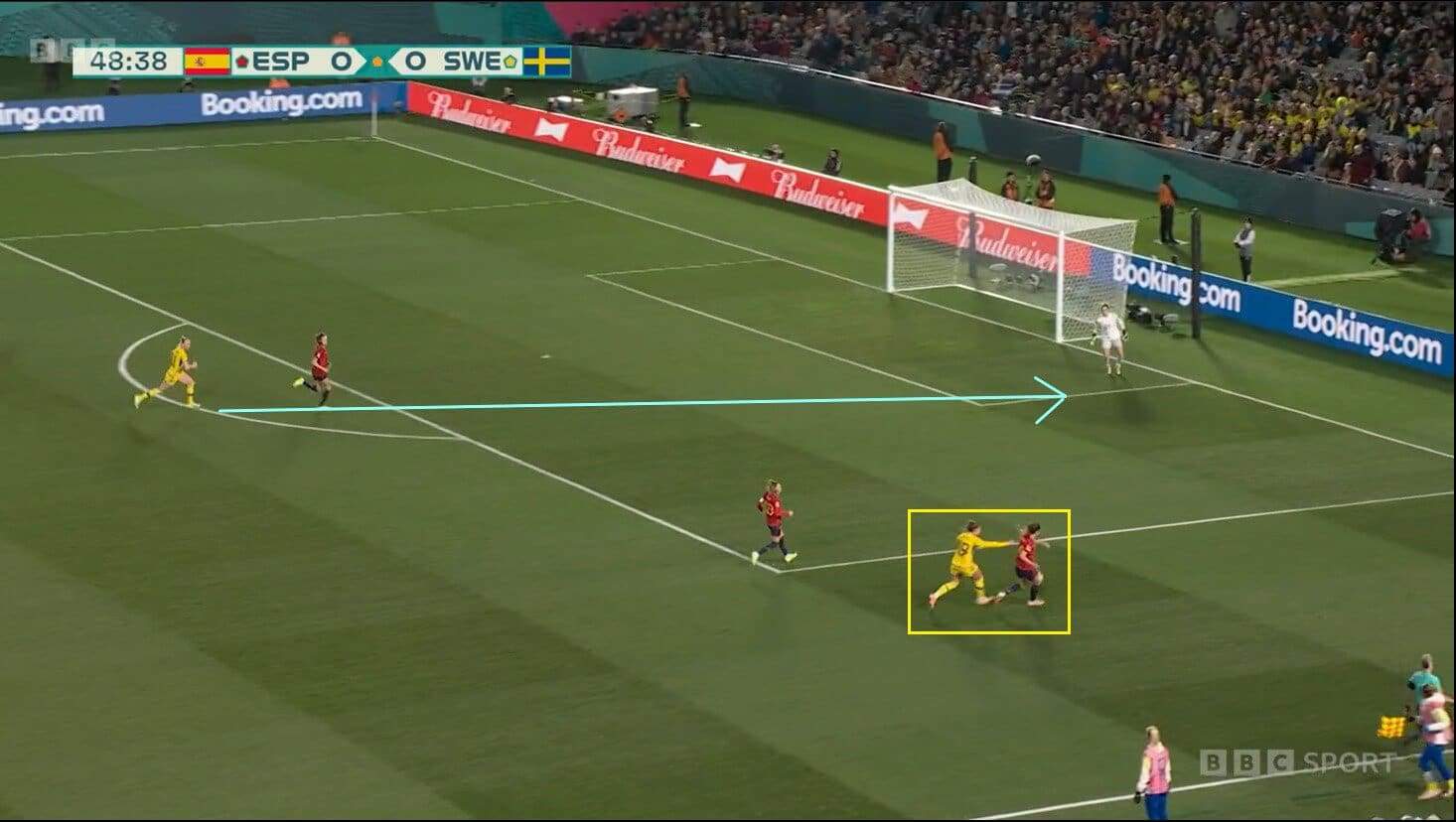
It wasn’t only about sitting back out of possession in this block, though, as Sweden also had moments when they demonstrated proactivity and tried to force the issue. In this case, Chelsea’s Johanna Rytting Kaneryd has led the closing down by getting tight to Laia Codina, whilst Blackstenius has moved to support her by running towards goalkeeper Cata Coll.
This type of pressing was something that worked to significant effect against Japan, with Blackstenius imposing at leading the line in moving up the field without the ball. The result was that Sweden took time away from the back three and prevented them from making the same devastating passes that they had been allowed to make before that quarter-final match.
Given its success in that game, it was no surprise that Sweden wanted to recreate it in this game, and there was no doubt that it gave them some success in winning the ball back in dangerous areas and causing Spain a few headaches inside their own third.
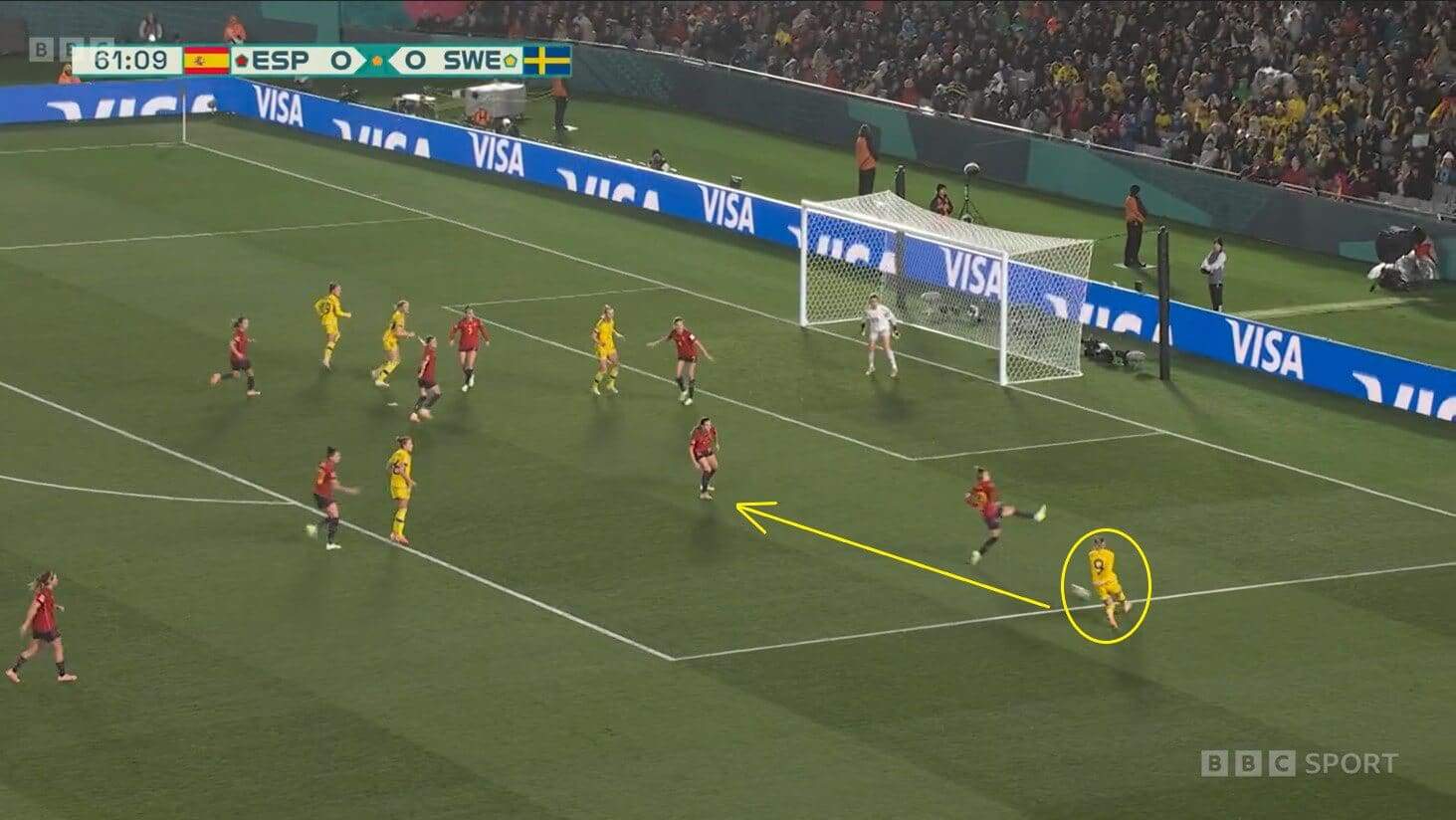
There might be some wondering why, given that this analysis has praised Sweden so much, they ended up on the wrong side of the scoreboard and with another semi-final exit, and the answer comes in their disappointing final third play.
Quite simply, when they did regain possession in advanced spaces, they were let down by their final pass or cross, meaning that chances never became anything more than that.
This is a perfect example of how they failed to convert their opportunities into shots on goal, with Kosovare Asllani looking for a teammate and having options but sending her cross towards Codina and allowing Spain to clear their lines.
This wasn’t the only thing that went wrong for them in these spaces, with there also being instances of players not making runs early enough and deliveries being overhit or lacking accuracy. Sweden will undoubtedly look back on these moments and know that, on another day, they could have maybe won the game had they made the most of them.
Conclusion
In conclusion, this tactical analysis has looked in detail at the World Cup semi-final between Spain and Sweden, breaking down the reasons that the former won and the latter ended up falling short once again.
To put it simply, deciding which of the two teams would win this game, given its often scrappy nature, was always going to come down to which of them would be able to make a difference with their changes. Spain’s squad depth is definitely better than Sweden’s in this tournament (a fact that has been pointed out in numerous analysis pieces).
However, that is never the be-all and end-all, as players do still need to make an impact, and Paralluelo deserves a lot of credit for the quality of her performance after being introduced.
This was not a game that will live long in the memory of those who watched it, but it will forever be etched in the memories of the Spanish players who took part in it for the simple reason that it was the moment when they finally reached a World Cup final.
They can now look forward to the prospect of a meeting with either Australia or England in Sydney’s Stadium Australia on Sunday and a chance of getting their hands on the biggest prize in the women’s game.





Comments